![]()
![]()
![]()
Use LEFT and RIGHT arrow keys to navigate between flashcards;
Use UP and DOWN arrow keys to flip the card;
H to show hint;
A reads text to speech;
31 Cards in this Set
- Front
- Back
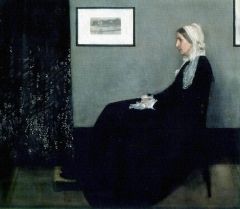
|
James McNeill Whistler
Arrangement in Gray & Black: The Artist's Mother 1871 Independent -Anna McNeill Whistler posed for the painting while living in London with her son. |
|
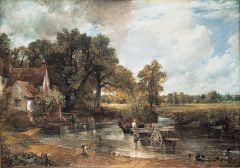
|
John Constable
The Hay Wain 1821 Romanticism -The Hay Wain is based on a site near Flatford on the river Stour, in Suffolk, England. -The cottage in the left of the image was rented by a farmer and stands behind Flatford Mill, owned by Constable's father. -All of these aspects illustrate Constable's idyllic view of his home county of Suffolk. |
|

|
John Singer Sargent
Lady Agnew of Lochnaw 1892-3 Independent -Andrew Noel Agnew, a barrister who had inherited the baronetcy and estates of Lochnaw in Galloway, commissioned this painting of his young wife, Gertrude Vernon (1865-1932), in 1892. -It was exhibited at the Royal Academy in 1898 and made Sargent's name. |
|
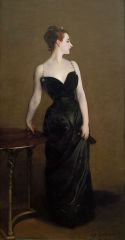
|
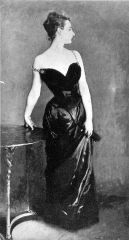
John Singer Sargent
Madame X 1883-4 Independent -The model is Madame Pierre Gautreau. - The model was an American expatriate who married a French banker, and became notorious in Parisian high society for her beauty and rumored infidelities. -Originally, this piece was painted with Gautreau's strap down. After a rough reception in The Salon he over painted the piece with the strap raised. |
|
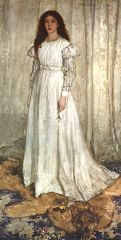
|
James Abbott McNeill Whistler
Symphony in White, No. 1 (The Girl in White) 1864 Independent -The model is Joanna Hiffernan, the artist's mistress. -Though the painting was originally called The White Girl, Whistler later started calling it Symphony in White, No. 1. By referring to his work in such abstract terms, he intended to emphasize his "art for art's sake" philosophy. -It was rejected both at the Royal Academy and at the Salon in Paris, but eventually accepted at the Salon des Refusés in 1863. |
|
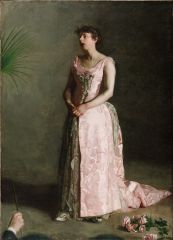
|
Thomas Eakins
The Concert Singer 1890 Realism - American -The Model is the singer Wenda Cook. -The painting was still unfinished when a rift developed between Eakins and Cook; one reason cited was his repeated request for her to pose nude, which Cook refused. Eakins finished the painting from Cook's shoes and dress, a circumstance that has been cited to account for a perceived awkwardness in the singer's stance and the placement of her right foot. |
|
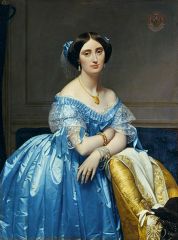
|
John-Auguste Ingres
Princesse de Broglie 1853 Neo-Classical -Ingres wasn't big on portraiture and this was the last female sitter he worked with. -In the upper left the family crest of the princess is painted. |
|

|
Édouard Manet
Olympia 1863 Realism - French / Impressionism -Manet's response to Titian's Venus. The painting caused shock and astonishment because she looks at the viewer with confrontational gaze and is adorned with a number of details identifying her as a prostitute. -The jury for the 1865 Salon accepted this painting despite their disapproval of the subject matter, because two years earlier, Manet’s Luncheon on the Grass created such a stir when it was rejected from the Salon. -Olympia became infamous and the painting had to be hung very high to protect it from physical attacks. -The model, Victorine Meurent, became an accomplished painter in her own right. |
|

|
Winslow Homer,
Prisoners from the Front 1866 Realism - American -Brigadier General Francis Channing Barlow (1834–1896), captured several Confederate officers on June 21, 1864. The background depicts the battlefield at Petersburg, Virginia. |
|
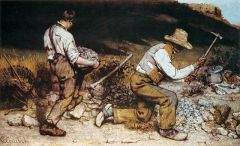
|
Gustave Courbet
The Stone Breakers 1849 Realism - American -The painting was first exhibited at the Paris Salon of 1850. It was destroyed during World War II, along with 154 other pictures, when a transport vehicle moving the pictures to the castle of Königstein, near Dresden, was bombed by Allied forces in February 1945. -Courbet wants to show what is "real," and so he has depicted a man that seems far too old and a boy that seems still too young for such back-breaking labors. -The hill reaches to the top of the canvas everywhere but the upper right corner, where a tiny patch of bright blue sky appears. The effect is to isolate these laborers, and to suggest that they are physically and socio-economically trapped by their work. |
|
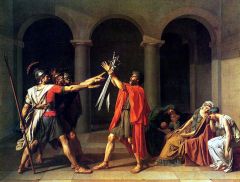
|
Jacques-Louis David
Oath of the Horatii 1784 Neo-Classical -Currently being displayed in The Louvre. In this painting the three Horatii brothers have been chosen to represent the city of Rome in a battle against three brothers from the neighboring city of Alba (the Curiatti). Here, the three Horatii brothers are swearing an oath on their swords which their father presents to them to fight until they die for their country. |
|
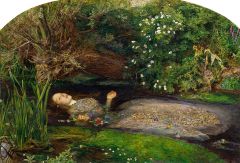
|
John Everett Millais
Ophelia 1851-2 Pre-Raphaelite -This is the moment in the play Hamlet when Ophelia, driven mad by Hamlet’s murder of her father. -His model was Elizabeth Siddal who later became wife and muse of Dante Gabriel Rossetti, another Pre-Raphaelite. - |
|
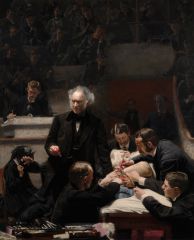
|
Thomas Eakins
The Gross Clinic 1875 Realism - American -Dr. Samuel D. Gross, a seventy-year-old professor dressed in a black frock coat, lectures a group of Jefferson Medical College students. Included among the group is a self-portrait of Eakins, who is seated to the right of the tunnel railing, sketching or writing. - The Gross Clinic has an important place documenting the history of medicine—both because it honors the emergence of surgery as a healing profession (previously, surgery was associated primarily with amputation), and because it shows us what the surgical theater looked like in the nineteenth century. -This is just prior to the adoption of a hygienic surgical environment (see asepsis). The Gross Clinic is thus often contrasted with Eakins's later painting The Agnew Clinic (1889), which depicts a cleaner, brighter, surgical theater. In comparing the two, the advancement in understanding of the prevention of infection is seen. |
|
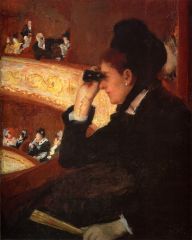
|
Mary Cassatt
Woman in Black at the Opera (In the Loge) 1879 Impressionism - The model in this piece is actually Cassatt's sister, Lydia?? - Unlike her friend Edgar Degas, Cassatt focused on the spectators rather than the performers, exposing the dramas in the audience. - Despite the man's intense gaze, the woman in black is not merely an object of his desire. Her own actions emphasize her independence and reflect the increasing social freedom accorded modern women. |
|

|
Auguste Renoir
Le Moulin de la Galette 1876 Impressionism - I representation of leisure time and and the still standing sun beams are perfect illustrations of some of the tropes of being an impressionist. - This piece is one of Renoir most important pieces. It was displayed at the Impressionist exhibition in 1877. - Some of Renoir's friends are present in this peice. |
|
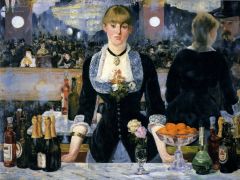
|
Édouard Manet
Bar at the Folies-Bergères, 1881-2 Realism/Impressionism - In this piece, we the viewer, are peering from the role of the man reflecting back in the top left, a higher class male. - Exhibited at the Paris Salon in 1882, was the last major work by French painter Édouard Manet. - The painting exemplifies Manet's commitment to Realism in its detailed representation of a contemporary scene. |
|

|
Claude Monet
Impression Sunrise 1872 Impressionism - Its subject is the harbor of Le Havre in France, using very loose brush strokes that suggest rather than delineate it. - Because he was trying to the feeling or atmosphere of the Harbor, rather than a detailed depiction, Monet decided to call it Impression Sunrise rather than Le Harve Sunrise |
|

|
Edgar Degas
Dancers, Pink and Green ca. 1890 Impressionism - The dancer models being caught stretching at one particular point in time is a common trope of impressionism. - The black figure creeping just beyond the wall is a depiction of the wealthy upper class men that used to frequent, support, and watch the dancers before and after performances. |
|
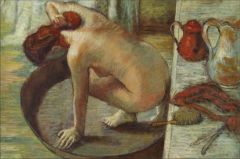
|
Edgar Degas
The Tub 1886 Impressionism - This piece make use of Japanese style distorted perspectives. - Presented at the eighth Impressionist exhibition in 1886, this pastel is one of a series of seven pictures produced by Degas in the mid 1880's on the theme of women at their ablutions |
|
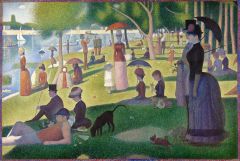
|
Georges Seurat
A Sunday Afternoon on the Island of La Grande Jatte 1884-6 Post Impressionism - Using pointillism and color theory, Seurat is able to complete this image without ever mixing colors. Instead, he uses pure dots of colors rather than standard brushstrokes. - This piece even comes with a painted frame in pointillism style. |
|
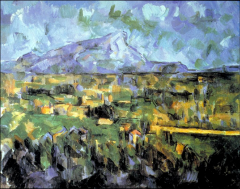
|
Paul Cézanne
Mont Sainte-Victoire Seen from Les Lauves 1902-6 Post Impressionism - Like Seurat, he does not use traditional brush strokes. Again, using color theory and the idea of warm colors coming forward nad cooler colors receding, he is blocks of color to create a more 3 dimensional feel. |
|

|
Paul Gauguin,
Vision After the Sermon (Jacob Wrestling with the Angel) 1888 Post Impressionism - Japanese wood print imspired. -- Distorted POV, compressed space, strange cropping. |
|

|
Vincent van Gogh
The Night Café 1888 Post Impressionism - The piece is the interior of Café de la Gare, in Arles, France that van Gogh stayed at for a while. - In the BG we see what he calls, "night prowlers." These are drunken people stay all night for free. Hence the title. |
|
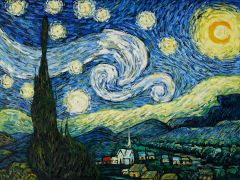
|
Vincent van Gogh
Starry Night 1889 Post Imprressionism - Painted in June 1889, it depicts the view outside of his sanatorium room window at Saint-Rémy-de-Provence (located in southern France) at night, although it was painted from memory during the day. |
|

|
Henri de Toulouse-Lautrec
La Goulue at the Moulin Rouge 1891 Post Impressionism - It is a colour lithograph from 1891, probably printed in about 3,000 copies, advertising the famous dancers La Goulue and "No-Bones" Valentin, and the new Paris dance hall Moulin Rouge. -Moulin Rouge: La Goulue is a bold, four-color lithograph depicting the famous cancan dancer La Goulue and her flexible partner Valentine le désossé made to advertise the popular French club, Moulin Rouge. Their audience is reduced to silhouettes in order to focus attention on the performers and evoke the Japanese art then in vogue. The triple repetition of the club's name draws the focus down to the central figure of the poster, La Goulue herself.[2] The stark white of her petticoats, depicted with just a few lines on the white paper, epitomizes Toulouse-Lautrec's boldly simplistic style, a sharp break from the text-heavy posters of the day.[1] |
|

|
Henri de Toulouse-Lautrec
At the Moulin Rouge 1892 Post Impressionism - The woman with the green face illuminated by artificial light is May Milton, another popular dancer of the day. - The artist himself appears in this painting. |
|
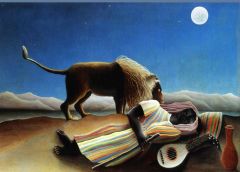
|
Henri Rousseau
The Sleeping Gypsy 1897 Symbolism - |
|
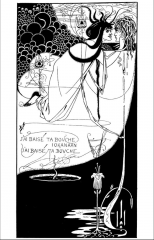
|
Aubrey Beardsley
Salome with the head of John the Baptist 1893 Art Nouveau |
|
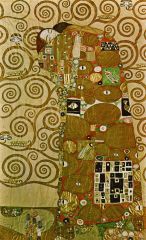
|
Gustav Klimt
Fulfillment 1905-8 Art Nouveau |
|
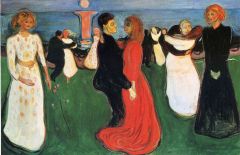
|
Edvard Munch
The Dance of Life 1900 Independent/Expressionist - The transition of the female figures from adolescence to sexual maturity to old age gives argument that the painting deals with the everlasting cycle of life. - Like The Scream, The Dance of Life belongs to a series called the Frieze of Life. - This piece touches on the troubles Munch had with the ladies. |
|
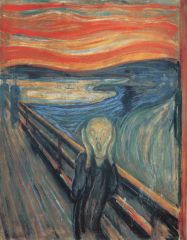
|
Edvard Munch
The Scream 1893 Independent/Expressionist - Most likely it represents Munch himself or, rather, what was going on in his head. To be fair, he had a family history of poor physical and mental health, and thought about these specters of doom with unwise frequency. -We do know that this scene had a real location, an overlook along a road traversing the Ekeberg hill, southeast of Oslo. |

